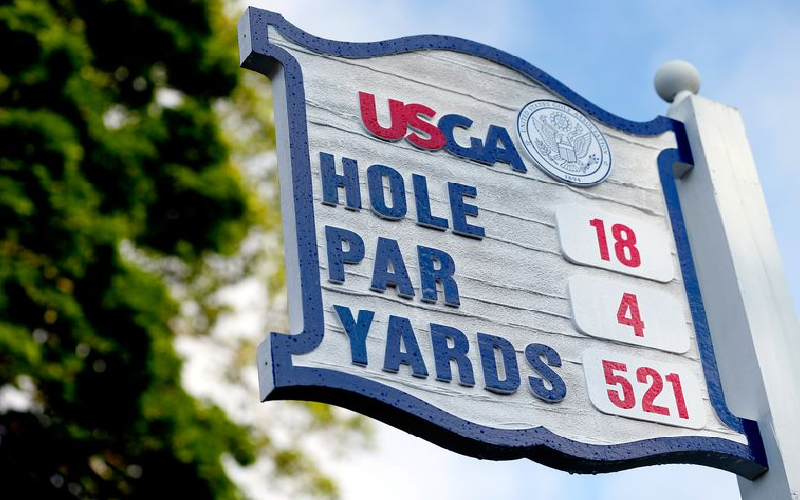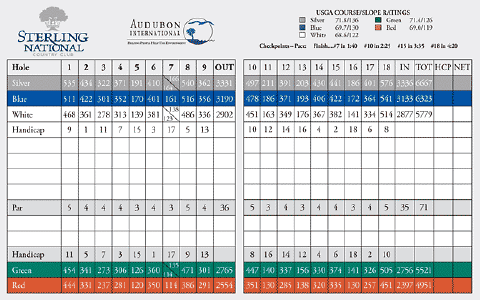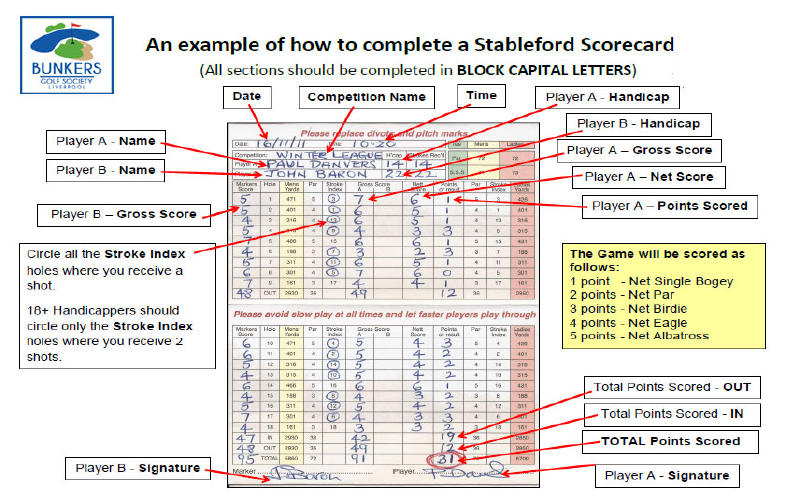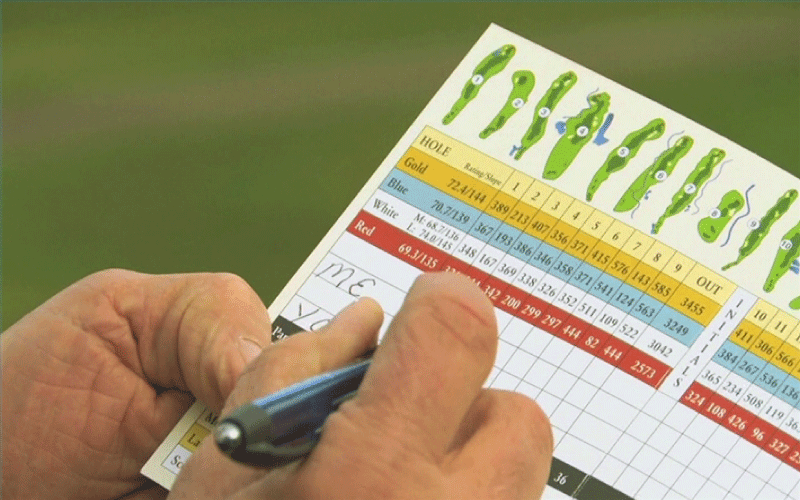Counting and keeping score in golf is pretty easy until you know the rules and terms. But when you are not accustomed to these terms and rules the scoring remains mysterious. In most sports and games players compete to score higher than their competitors. But in Golf, It is unlike most other sports and games – it’s the person with the lowest score who wins.
The goal of each golf match is to put a ball from Point A to Point B using clubs with the least amount of strokes. In competitive matches, you need to complete 18 holes in total and your final score will be counted after putting balls to all these 18 holes. But you need to record your score after putting the ball to each hole.
Table of Content

Par gives you a guideline on how many strokes a golfer may need to put the ball into the hole. The fewer strokes a golfer takes, the better. A total of 18 holes to be completed in a course of a single round of play. When it comes to any competition, the golfer who takes the fewest strokes to complete the round wins.
Scoring Related Terms That You Should Know
If you are new to Golf, you will listen to a lot of new terms related to scoring as well. Though you will find all these terms in our another article titled “Golf Terms and Meanings for Beginners” we thought let’s just sort out only the relevant ones here for better understanding.
Birdies, Eagles are appreciated as a good play. Based on Par score Albatross and Hole in one can be the same.
| Terms | Meaning/ Explanation | Hypothetical Example Explanation |
| Par | The term “par” is an abbreviation for “professional average result.” Actually, it’s a standard score for a hole based on its length. | Suppose you are trying to put the ball within a 300 yards hole and most professional golfers usually complete it by 4 strokes. Then 4 strokes is Par for that hole. If you put the ball on 4 strokes you score a Par. |
| Birdie | A hole played in just one stroke under par | In reference to the previous example, if you put the ball in the hole in 3 strokes, you have scored a Birdie. |
| Bogey | A hole played in just one stroke over par | In reference to the previous example, if you put the ball in the hole in 5 strokes, you have scored a Bogey. |
| Eagle | A hole performed in two strokes under par | In reference to the previous example, if you put the ball in the hole in 2 strokes, you have scored an Eagle. |
| Double Bogey | a hole played two strokes over par | In reference to the previous example, if you put the ball in the hole in 6 strokes, you have scored a Double Bogey. |
| Double Eagle | a hole played three strokes under par. It is also called an Albatross | In reference to the previous example, if you put the ball in the hole in 1 stroke, you have scored a Double Eagle or Albatross. |
| Hole In One | an act of getting the golf ball directly from the tee into the hole with just one stroke | When you put your golf ball from Point A to Point B in a single stroke, You scored Hole In One. |
Golf Scoring Formats
The United States Golf Association (USGA) and Royal and Ancient (R&A) collaborate to create and enforce the enormous amount of rules covering almost every instance that can occur in the game. Golf’s official rules are full of obscure rulings for instances that will likely never occur. For which, we have just covered the most common rules – the ones you would likely encounter on the course a few times per round. There are 3 (three) main formats used for keeping score in golf (listed in order of commonness):
- Stroke Play Method: Counts each stroke and lowest stroke player wins.

- Match Play Method: Count each stroke on each hole and compare it on each hole. The player who wins the most holes wins the match.
- Stableford Method: Your score in relation to par is converted into points, and it’s the number of total points, not the strokes that determines the winner.

How To Keep Score
A golf game round has 18 holes to complete and each hole requires multiple strokes mostly. You can very well understand that the round is quite a lengthy one and you may not remember all the scores accurately. So, get a scorecard first. You can keep track of the scorecard or you may appoint someone to assist you in recording score. You will record the score on the scorecard but not your ones, you will keep score of your opponents and show it to him to check whether you entered correctly on wrong.
And he will put initials after checking. And the same goes for your turn as well. Your opponent will record your score then let you check and you put initials when its correct score. So if your opponent makes a mistake (even assuming it’s an honest one) that somehow makes your score worse than it should be, you have to take the blame for it.
Every time you attempt to take a swing on the ball will be counted as a stroke whether you hit the ball or not. But an interesting fact is if you mistakenly hit the ball while practicing your swing it doesn’t count as a stroke. As you will be recording your opposition score as well as yours, know the rules and penalties of breaking any rules or faults to settle any disputes regarding the score. Penalties are added extra shots for any faults like hitting the ball out of the course or in the water and so on. Few common penalties you must know are:
- If you hit a ball in the water, drop a new ball in the designated location and take a 1-stroke penalty.
- If you hit the ball out of bounds (as indicated by white stakes), re-hit from the original location and take a 2-stroke penalty.
- If you lose a ball, re-hit from the original location and take a 2-stroke penalty.
Now let’s get on to the game-play and keep the count of strokes. Each hole will have a number of strokes listed under “Par”. Keep a note of that because this is the average number of strokes it should take to get the ball in the hole. And score will be counted on that Par basis. For example, if the par is 3 and you make a 4, then your score can be viewed as 1-over. If the par for the course is 80 and you finished the course with a 95, then your score is 15-over. This is where the terms are required to know. You should know that a birdie is one stroke under par, an eagle is two under par, and a bogey is one over par. Some players decide that they can take no more strokes for each hole than a double bogey, or 2 points over par. If you know the rules prior to a match it will be easy to understand as well. Now add up your scores from each hole for a cumulative total. Double-check it. And cross-check it with your competitors to make sure they are correct too. You must check it and then sign your scorecard to make it official. The player with the least amount of points wins the game. Let’s summarize the process with some steps.
Step 1: Know the rules and penalties properly.
Step 2: Take a scorecard.

Step 3: Keep records of a number of strokes needed on each hole.
Step 4: Add up scores on several holes. Double-check it.
Step 5: Cross-check with competitors and approve it with a sign. You may add and cross-check after several holes so that you don’t have to do too many calculations at the end and can settle disputes over the score more easily.
The above method is proper for the stroke-play system; the most popular scoring format. Don’t worry about the other formats. The process is all the same until step 4. In the match play system on step 5, you will add up scores after each hole and find out the winner of that particular hole. Winner gets +1 on that hole and the loser gets -1. The player with most hole points wins the match. In this method, if any player scores +10 holes then playing rest from the 18 hole becomes a formality.
The Stableford system scoring is all the same as stroke-play. The only difference is designated points are counted rather than actual strokes played.
Tips for Keeping Score
The following tips will help you in the long run while keeping score in golf.
- Pay attention to how many shots you hit while playing a hole, so you won’t have to count them up after finishing. Keep track of the score on the scorecard.
- Keep track of your score and the scores of the other players in your group.
- Always write down your score as soon as you complete the hole to avoid forgetting.
- Cell phone apps and other tools are available that help you keep score.
- Know the rules, penalties clearly
- Count every purposeful attempt to strike a ball as a stroke.
- cross-check after several holes so that you don’t have to do too many calculations at the end and can settle disputes over the score more easily.
Conclusion
Keeping score is as important as playing a perfect shot. Because score determines the winner and you will be keeping track of others’ scores to know your target to win. There are 3 different methods of keeping score from which stroke-play is the most popular in most tournaments.
Know the rules and penalties and be attentive to each stroke you play as well as how others play and keep score. That is the ultimate method of score keeping in golf.

